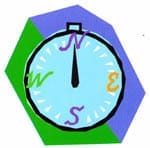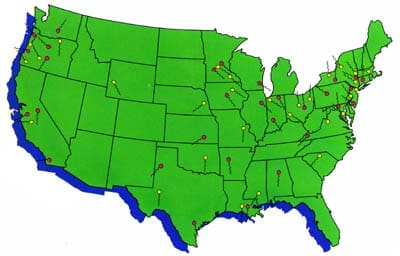Which Way Is the Wind Blowing?
Experiment #4
Children can use helium-filled balloons to observe wind direction. They use a magnetic compass to measure direction. A magnetic compass to measure direction. A magnetic compass measure the earth’s magnetic north, which is slightly different than the true north directly below the North Star. They will see that even a “steady” wind changes direction frequently and that it also changes its speed.
Getting Started:
On the playground or from the classroom window, call the children’s attention to the wind. How can we tell it is blowing? (From the classroom by watching leaves, branches or flags move. Outside you also can feel it.)
Which way is the wind blowing? What do we mean by “which way”? (From and to some compass direction. From the west and to the east, for example.) How could we measure the direction? (Use a magnetic compass.)
Collecting Data:
Wind Direction.
This experiment is done outside either with the entire class using one balloon or with children in groups, each group having a balloon.
Tie the helium-filled balloon to a string — 20 to 50 feet long. Choose a site where the balloons will not get entangled on nearby objects. Tie a loop in the end of the string so it is easy to hold — or tether it to a heavy object such as a hammer on the ground or a fence.
object such as a hammer on the ground or a fence.
Have the students observe and comment on the fact that (assuming the wind is blowing) the string does not go straight up, but inclines at an angle away from the wind.
Have several children measure the direction the string inclines — that is, the direction the wind is blowing — with a magnetic compass. The children may need instruction on how to use a compass to measure directions. For example, they will need to know that the compass needle points north and when they hold the compass to measure a direction, they should hold it so that the N is at the end of the needle. To observe the correct direction, the compass must be held at a place where the balloon appears to be vertically above the tether point –that is, directly upwind.
Have the children record the wind direction as a compass reading. They then can make a map of the experiment site, using arrows to show wind direction.
Changes in Wind Direction.
The wind does not often blow steadily from one direction. Usually, it wobbles back and forth a few degrees. If it does when you are doing your experiment, have the children try to measure how big the wobble is. Have them record the directions they observe. They can make a map of the observation site, using arrows to show the different wind directions.
Extensions.
You may want the children to try other ways to demonstrate wind direction such as observing weather varies, blowing soap bubbles and flying kites.
Charting Results:
In addition to all of the charts and observations the students have made conducting the experiment, ask them to compare theirs to other students’ work. Show them the map below. It records wind directions observed by student teams using the methods of this experiment. Measurements were made April 24, 1989, as part of a national weather experiment. Have the children note that the wind blows in different directions at the various sites.